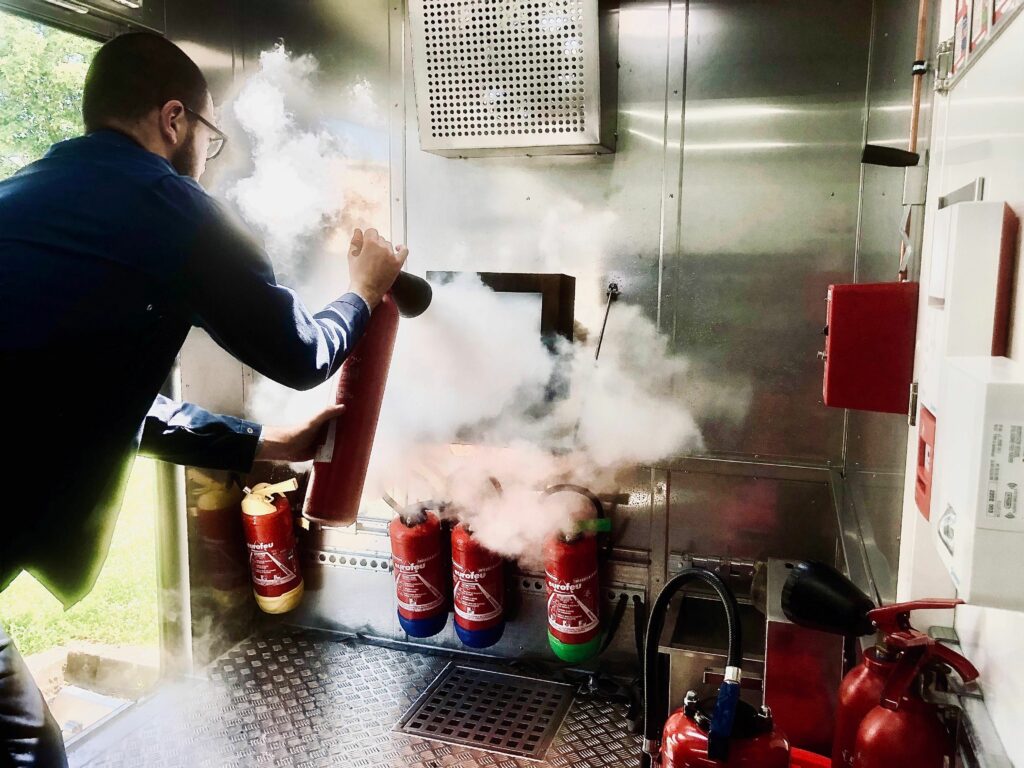Is fire extinguisher training compulsory?
The use of a fire extinguisher is a key element of fire safety in the workplace. It's all about understanding the regulations, the legal obligations and the need for appropriate training. This training, which is often compulsory, enables you to master the handling and use of extinguishers. It is of interest to companies of all sizes, especially those with more than 50 employees or using flammable materials.
Understanding the fire extinguisher training obligation
Fire extinguisher training is essential for workplace safety. It enables employees to acquire the skills they need to react effectively in the event of a fire. This obligation is governed by article R4227-28 of the French Labor Code, which requires employers to train their staff in companies with over 50 employees or handling flammable materials.
The training includes several aspects:
- Alarm signal recognition
- Proper use of different types of extinguishers
- Identifying fire classes
A practical exercise is often carried out to reinforce these skills. A concrete example would be the use of a carbon dioxide extinguisher on a simulated electrical fire, allowing participants to practice on a realistic situation. This ensures better preparation for a potential fire.
Fire extinguisher training regulations
The role of the Labour Code
The French Labor Code plays a fundamental role in workplace fire safety. It imposes clear obligations on employers to guarantee the training of their employees. Under article R4227-28, all employees must be trained in the use of fire extinguishers, so they can react effectively in the event of a fire. This training is essential to minimize risks and ensure everyone's safety.
Companies must also ensure that equipment is in good working order and accessible. Here are a few essential obligations for employers:
- Conduct regular evacuation drills
- Train employees on safety instructions
- Maintain fire extinguishers and other safety equipment in excellent condition
By complying with these rules, companies protect not only their employees, but also their material assets. A case in point is practical training in the use of a water-spray extinguisher, which is often incorporated into evacuation drills.
Legal requirements for fire extinguisher training
Legal obligations relating to fire extinguisher training are mainly governed by the French Labor Code. Article R4227-28 requires employers to train their employees in the use of fire extinguishers to ensure safety in the event of fire. This training is mandatory for companies with over 50 employees and those handling flammable materials.
Training should include practical exercises to familiarize employees with the different types of extinguisher and their appropriate use. This may include the use of a dry powder extinguisher on a Class B fire, for example.
Employers are also required to ensure that fire extinguishers are properly maintained and easily accessible. A safety register must be regularly updated to record details of every training course attended by staff, reinforcing compliance with safety standards.
Specific rules for ERP
Establishments open to the public (ERP) must comply with specific fire safety regulations. Each level must be equipped with at least one water-spray extinguisher per 200 m². Staff must be trained in the use of fire extinguishers, to ensure rapid intervention in the event of a fire.
Sessions include practical exercises, often using laser extinguishers to minimize risk. In particular, employees learn how to recognize alarms and use first-aid equipment. Here are just a few of the actions required for ERP facilities:
- Organize regular evacuation drills
- Maintain equipment in good condition
- Ensuring accessibility to fire extinguishers
The employer must ensure that staff are trained and ready to react, thus contributing to collective safety and compliance with current standards.
Fire extinguisher training objectives
To achieve the objectives of fire extinguisher training, it is essential to develop specific skills. Here are a few key points to master:
- Understand how fire works: Recognize the causes and classes of fire so you can intervene quickly.
- Using different types of extinguishers: Choosing the right extinguisher for each type of fire, e.g. a dry powder extinguisher for Class B fires.
- Implementing first-response resources: Learn how to handle fire extinguishers safely in the event of a fire.
- Isolating hazards and sounding the alarm: Identify potential hazards and know how to alert emergency services effectively.
These skills ensure greater responsiveness in the event of fire, thus contributing to collective safety within the company. Regular practice and drills help reinforce these skills over the long term.
The consequences of not having received fire extinguisher training
Risks for the company and its employees
Lack of training in fire extinguisher handling poses significant risks for companies and their employees. Without proper training, employees may act ineffectively or inappropriately in the event of a fire, increasing the danger to themselves and to the facility as a whole.
This can lead to serious injury or loss of life, as well as considerable material damage. The financial consequences can be severe, ranging from loss of property to prolonged business interruptions.
Companies also risk legal sanctions. Failure to comply with fire safety standards may result in fines, and the employer may be held civilly and criminally liable in the event of an accident.
To limit these risks, it is crucial to provide regular training and to ensure that all staff are well prepared to react effectively.
Employer liability in the event of fire
The employer has an essential responsibility in terms of fire safety. He or she must ensure that employees are trained in the use of fire extinguishers and evacuation procedures, thus guaranteeing their ability to react quickly. Failure to do so can have a number of consequences.
Legal implications include substantial fines and possible civil and criminal liability. Penalties can be severe, including imprisonment in the most serious cases.
To avoid these risks, employers must implement a regular training program and document sessions in a safety register. This not only demonstrates compliance with standards, but also boosts employee confidence. A well-prepared company reduces the risk of material and human damage.

Read our other articles here!


